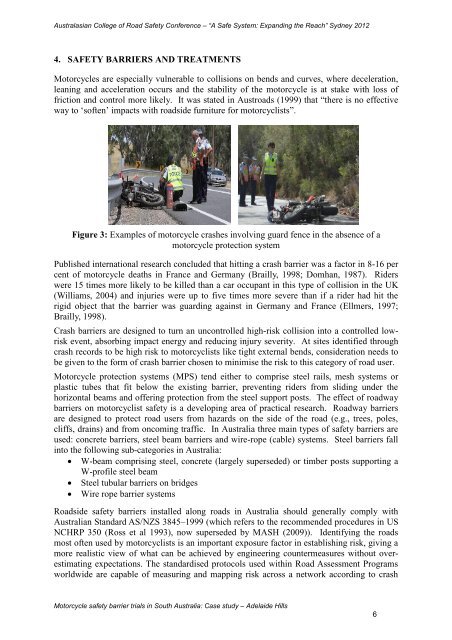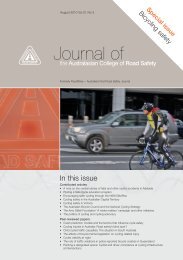Motorcycle safety barrier trials in South Australia: Case study
Motorcycle safety barrier trials in South Australia: Case study
Motorcycle safety barrier trials in South Australia: Case study
You also want an ePaper? Increase the reach of your titles
YUMPU automatically turns print PDFs into web optimized ePapers that Google loves.
Australasian College of Road Safety Conference – “A Safe System: Expand<strong>in</strong>g the Reach” Sydney 20124. SAFETY BARRIERS AND TREATMENTS<strong>Motorcycle</strong>s are especially vulnerable to collisions on bends and curves, where deceleration,lean<strong>in</strong>g and acceleration occurs and the stability of the motorcycle is at stake with loss offriction and control more likely. It was stated <strong>in</strong> Austroads (1999) that “there is no effectiveway to ‘soften’ impacts with roadside furniture for motorcyclists”.Figure 3: Examples of motorcycle crashes <strong>in</strong>volv<strong>in</strong>g guard fence <strong>in</strong> the absence of amotorcycle protection systemPublished <strong>in</strong>ternational research concluded that hitt<strong>in</strong>g a crash <strong>barrier</strong> was a factor <strong>in</strong> 8-16 percent of motorcycle deaths <strong>in</strong> France and Germany (Brailly, 1998; Domhan, 1987). Riderswere 15 times more likely to be killed than a car occupant <strong>in</strong> this type of collision <strong>in</strong> the UK(Williams, 2004) and <strong>in</strong>juries were up to five times more severe than if a rider had hit therigid object that the <strong>barrier</strong> was guard<strong>in</strong>g aga<strong>in</strong>st <strong>in</strong> Germany and France (Ellmers, 1997;Brailly, 1998).Crash <strong>barrier</strong>s are designed to turn an uncontrolled high-risk collision <strong>in</strong>to a controlled lowriskevent, absorb<strong>in</strong>g impact energy and reduc<strong>in</strong>g <strong>in</strong>jury severity. At sites identified throughcrash records to be high risk to motorcyclists like tight external bends, consideration needs tobe given to the form of crash <strong>barrier</strong> chosen to m<strong>in</strong>imise the risk to this category of road user.<strong>Motorcycle</strong> protection systems (MPS) tend either to comprise steel rails, mesh systems orplastic tubes that fit below the exist<strong>in</strong>g <strong>barrier</strong>, prevent<strong>in</strong>g riders from slid<strong>in</strong>g under thehorizontal beams and offer<strong>in</strong>g protection from the steel support posts. The effect of roadway<strong>barrier</strong>s on motorcyclist <strong>safety</strong> is a develop<strong>in</strong>g area of practical research. Roadway <strong>barrier</strong>sare designed to protect road users from hazards on the side of the road (e.g., trees, poles,cliffs, dra<strong>in</strong>s) and from oncom<strong>in</strong>g traffic. In <strong>Australia</strong> three ma<strong>in</strong> types of <strong>safety</strong> <strong>barrier</strong>s areused: concrete <strong>barrier</strong>s, steel beam <strong>barrier</strong>s and wire-rope (cable) systems. Steel <strong>barrier</strong>s fall<strong>in</strong>to the follow<strong>in</strong>g sub-categories <strong>in</strong> <strong>Australia</strong>: W-beam compris<strong>in</strong>g steel, concrete (largely superseded) or timber posts support<strong>in</strong>g aW-profile steel beam Steel tubular <strong>barrier</strong>s on bridges Wire rope <strong>barrier</strong> systemsRoadside <strong>safety</strong> <strong>barrier</strong>s <strong>in</strong>stalled along roads <strong>in</strong> <strong>Australia</strong> should generally comply with<strong>Australia</strong>n Standard AS/NZS 3845–1999 (which refers to the recommended procedures <strong>in</strong> USNCHRP 350 (Ross et al 1993), now superseded by MASH (2009)). Identify<strong>in</strong>g the roadsmost often used by motorcyclists is an important exposure factor <strong>in</strong> establish<strong>in</strong>g risk, giv<strong>in</strong>g amore realistic view of what can be achieved by eng<strong>in</strong>eer<strong>in</strong>g countermeasures without overestimat<strong>in</strong>gexpectations. The standardised protocols used with<strong>in</strong> Road Assessment Programsworldwide are capable of measur<strong>in</strong>g and mapp<strong>in</strong>g risk across a network accord<strong>in</strong>g to crash<strong>Motorcycle</strong> <strong>safety</strong> <strong>barrier</strong> <strong>trials</strong> <strong>in</strong> <strong>South</strong> <strong>Australia</strong>: <strong>Case</strong> <strong>study</strong> – Adelaide Hills6





